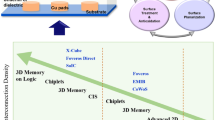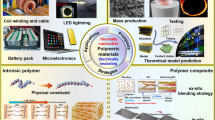The purpose of this study was to develop the thermosonic flip-chip bonding process for gold stud bumps bonded onto copper electrodes on an alumina substrate. Copper electrodes were deposited with silver as the bonding layer and with titanium as the diffusion barrier layer. Deposition of these layers on copper electrodes improves the bonding quality between the gold stud bumps and copper electrodes. With appropriate bonding parameters, 100% bondability was achieved. Bonding strength between the gold stud bumps and copper electrodes was much higher than the value converted from the standards of the Joint Electron Device Engineering Council (JEDEC). The effects of process parameters, including bonding force, ultrasonic power, and bonding time, on bonding strength were also investigated. Experimental results indicate that bonding strength increased as bonding force and ultrasonic power increased and did not deteriorate after prolonged storage at elevated temperatures. Thus, the reliability of the high-temperature storage (HTS) test for gold stud bumps flip-chip bonded onto a silver bonding layer and titanium diffusion barrier layer is not a concern. Deposition of these two layers on copper electrodes is an effective and direct method for thermosonic flip-chip bonding of gold stud bumps to a substrate, and ensures excellent bond quality. Applications such as flip-chip bonding of chips with low pin counts or light-emitting diode (LED) packaging are appropriate.
Similar content being viewed by others
References
K. Gilleo, Area Array Packaging Handbook: Manufacturing and Assembly (McGraw-Hill, New York, 2001), p. 7.14
J. Ida, M. Yoshimaru, T. Usami, A. Ohtomo, K. Shimokawa, A. Kita et al., Proceedings of VLSI Technology Symposium (1994), p. 59
M. Miyamoto, T. Takeda, T. Furusawa, IEEE Trans. Electron. Dev. 44, 250 (1997) doi:10.1109/16.557712
G. Deltoro, N. Sharif, 24th IEEE/CPMT (1999), p. 185
J.N. Aoh, C.L. Chuang, J. Electron. Mater. 33, 290 (2004) doi:10.1007/s11664-004-0135-5
J.N. Aoh, C.L. Chuang, J. Electron. Mater. 33, 300 (2004) doi:10.1007/s11664-004-0136-4
C.L. Chuang, J.N. Aoh, J. Electron. Mater. 35, 1693 (2006) doi:10.1007/s11664-006-0220-z
C.L. Chuang, Microelectron. Eng. 84, 551 (2007) doi:10.1016/j.mee.2006.11.005
Y.C. Chan, D.Y. Luk, Microelectron. Reliab. 42, 1195 (2002) doi:10.1016/S0026-2714(02)00089-6
JEDEC (EIA), Solid State Technology Product Engineering Council (Arlington, 1998)
Acknowledgements
The authors would like to thank the National Science Council of the Republic of China, Taiwan, for financially supporting this research under Contact No. NSC-94-2212-E-040-011. The authors are also grateful to Industrial Technology Research Institute (ITRI), South Branch for providing the experimental facilities.
Author information
Authors and Affiliations
Corresponding author
Rights and permissions
About this article
Cite this article
Chuang, CL., Aoh, JN., Liao, QA. et al. Gold Stud Bumps Flip-Chip Bonded onto Copper Electrodes with Titanium and Silver Layers. J. Electron. Mater. 37, 1742–1750 (2008). https://doi.org/10.1007/s11664-008-0510-8
Received:
Accepted:
Published:
Issue Date:
DOI: https://doi.org/10.1007/s11664-008-0510-8




